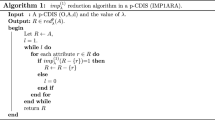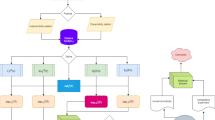Abstract
In many practical applications of machine learning, only part of data is labeled because the cost of assessing class label is relatively high. This paper concentrates on measures of uncertainty for a partial label categorical decision information system (p-CDIS), and considers an application to semi-supervised attribute reduction. Firstly, two decision information systems (DISs) can be induced by a p-CDIS (U, C, d): one is for a decision information system for labeled categorical data \((U^l,C,d)\) and the other one is a decision information system for unlabeled categorical data \((U^u,C,d)\), and the missing rate of labels in (U, C, d) is introduced. In view of partial label data, the existential research did not take into account the missing rate of labels and only considered one importance of each attribute subset. Then, four importance of an attribute subset \(P\subseteq C\) in (U, C, d) are defined based on an indiscernibility relation. They are the weighted sum of the importance of P in \((U^l,C,d)\) and \((U^u,C,d)\) determined by the missing rate of labels. These four importance can be regarded as four uncertainty measurements (UMs) for (U, P, d). Next, numerical experiments and statistical tests are carried out on 15 datasets of UCI to demonstrate four UMs’ advantages and disadvantages. Finally, as an application for UM in p-CDIS, two better UMs are used as semi-supervised attribute reduction and two corresponding algorithms are designed that can automatically adapt to different missing rates of labels. The experimental results show the feasibility and superiority of the designed algorithms.










Similar content being viewed by others
Data availability and access
The data used or analyzed during the current study are available from the corresponding author after the paper is accepted for publication.
References
Andrzej C (2003) Automatic identication of sound source position employing neural networks and rough sets. Pattern Recognit Lett 24(6):921–933
Benabdeslem K, Hindawi M (2014) Efficient semi-supervised feature selection: constraint, relevance and redundancy. IEEE Trans Knowl Data Eng 26:1131–1143
Bao WX, Hang JY, Zhang ML (2021) Partial label dimensionality reduction via confidence-based dependence maximization. In: Proceedings of the 27th ACM SIGKDD Conference on Knowledge Discovery & Data Mining, pp. 46–54
Bao WX, Hang JY, Zhang ML (2022) Submodular feature selection for partial label learning. In: Proceedings of the 28th ACM SIGKDD Conference on Knowledge Discovery and Data Mining, pp. 26–34
Campagner A, Ciucci D (2022) Rough-set based genetic algorithms for weakly supervised feature selection. International Conference on Information Processing and Management of Uncertainty in Knowledge-Based Systems. Springer, Cham, pp 761–773
Campagner A, Ciucci D, Huellermeier E (2021) Rough set-based feature selection for weakly labeled data. Int J Approx Reason 136:150–167
Blum A, Mitchell T (1998) Combining labeled and unlabeled data with cortraining//Proceedings of the 11th annual Conference on Computational Learning Theory. New York: ACM, 92–100
Beaubouef T, Petry FE, Arora G (1998) Information-theoretic measures of uncertainty for rough sets and rough relational databases. Inf Sci 109:185–195
Chen YQ, Gao W, Zhu TS (2002) Learning prosodic patterns for mandarin speech synthesis. J Intell Inf Syst 19(1):95–109
Chen Z, Liu KY, Yang XB, Fujita H (2022) Random sampling accelerator for attribute reduction. Int J Approx Reason 140:75–91
Chen Y, Liu KY, Song JJ, Fujita H, Yang XB, Qian YH (2020) Attribute group for attribute reduction. Inf Sci 535:64–80
Girish C, Ferat S (2014) A survey on feature selection methods. Comput Electr Eng 40:16–28
Dai JH, Hu QH, Zhang JH, Hu H, Zheng NG (2017) Attribute selection for partially labeled categorical data by rough set approach. IEEE Trans Cybernet 47:2460–2471
Dai JH, Wang WS, Zhang CC, Qu SJ (2023) Semi-supervised attribute reduction via attribute indiscernibility. Int J Mach Learn Cybernet 14(4):1445–1464
Feofanov V, Devijver E, Amini MR (2022) Wrapper feature selection with partially labeled data. Appl Intell 52(11):12316–12329
Fan TF, Liu DR, Tzeng GH (2007) Rough set-based logics for multicriteria decision analysis. European J Operat Res 182:340–355
Forestier G, Wemmert C (2016) Semi-supervised learning using multiple clustering with limited labeled data. Inf Sci 361–362:48–65
He XF, Deng C, Partha N (2005) Laplacian score for feature selection//Proceedings of the 18th International Conference on Neural Information Processing Systems (NIPS’05). Cambridge, USA: MIT Press, 507–514
Handl J, Knowles J (2006) Semi-supervised feature selection via multi-objective optimization//The 2006 International Joint Conference on Neural Networks
Hirano S, Tsumoto S (2005) Rough representation of a region of interest in medical images. Int J Approx Reason 40(1–2):23–34
Han YH, Yang Y, Yan Y, Ma ZG, Zhou XF (2015) Semisupervised feature selection via spline regression for video semantic recognition. IEEE Trans Neural Netw Learn Syst 26:252–264
Weston J, Andre E, Bernhard S (2003) Use of the zero-norm with linear models and kernel methods. J Mach Learn Res 3:1439–1461
Jiang ZH, Liu KY, Yang XB, Yu HL, Fujita H, Qian YH (2020) Accelerator for supervised neighborhood based attribute reduction. Int J Approx Reason 119:122–150
Jiang F, Sui YF, Cao CG (2010) An information entropy-based approach to outlier detection in rough sets. Exp Syst Appl 37:6338–6344
Jain P, Tiwari AK, Som T (2020) A fitting model based intuitionistic fuzzy rough feature selection. Eng Appl Art Intell 89:103421
Kohavi R, John GH (1997) Wrappers for feature subset selection. Art Intell 97(1–2):273–324
Liu GL (2022) Attribute reduction algorithms determined by invariants for decision tables. Cognit Comput 14:1818–1825
Liang JY, Shi ZZ, Li DY (2006) Information entropy, rough entropy and knowledge granulation in incomplete information systems. Int J Gen Syst 35:641–654
Liu KY, Yang XB, Yu HL, Mi JS (2019) Rough set based semi-supervised feature selection via ensemble selector. Knowl-Based Syst 165:282–296
Kryszkiewicz M (1999) Rules in incomplete information systems. Inf Sci 113:271–292
Miao D, Gao C, Zhang N (2011) Diverse reduct subspaces based co-training for partially labeled data. Int J Approx Reason 52:1103–1117
Nakatani Y, Zhu K, Uehara K (2007) Semi-supervised learning using feature selection based on maximum density subgraphs. Syst Comput Japan 38:32–43
Pawlak Z (1982) Rough sets. Int J Comput Inf Sci 11:341–356
Qian YH, Liang JY (2008) Combination entropy and combination granulation in rough set theory. Int J Uncert Fuzz Knowl-Based Syst 16:179–193
Ren JY, Qiu ZY, Fan W (2008) Forward semi-supervised feature selectio. in: Proceedings of the 12th Pacific-Asia conference on Advances in Knowledge Discovery and Data Mining (PAKDD’08). Springer-Verlag, Berlin, pp. 970–976
Shannon C (1948) A mathematical theory of communication. Bell Syst Tech J 27:379–423
Sang BB, Chen HM, Yang L, Li TR, Xu WH (2021) Incremental feature selection using a conditional entropy based on fuzzy dominance neighborhood rough sets. IEEE Trans Fuzz Syst 30(6):1683–1697
UCI Machine Learning Repository. http://archive.ics.uci.edu/ml/datasets.html
Wierman MJ (1999) Measuring uncertainty in rough set theory. Int J Gen Syst 28:283–297
Wang XZ, Tsang ECC, Zhao SY, Chen DG, Yeung DS (2007) Learning fuzzy rules from fuzzy samples based on rough set technique. Inf Sci 177:4493–4514
Wang CZ, Wang Y, Shao MW, Qian YH, Chen DG (2020) Fuzzy rough attribute reduction for categorical data. IEEE Trans Fuzz Syst 28:818–830
Wan L, Xia SJ, Zhu Y, Lyu ZH (2021) An improved semi-supervised feature selection algorithm based on information entropy. Stat Decis Making 17:66–70
Wang YB, Chen XJ, Dong K (2019) Attribute reduction via local conditional entropy. Int J Mach Learn Cybernet 10:3619–3634
Yuan Z, Chen HM, Zhang PF, Wan JH, Li TR (2021) A novel unsupervised approach to heterogeneous feature selection based on fuzzy mutual information. IEEE Trans Fuzz Syst 30(9):3395–3409
Yang X, Chen Y, Fujita H, Liu D, Li TR (2022) Mixed data-driven sequential three-way decision via subjective-objective dynamic fusion. Knowl-Based Syst 237:107728
Zhao MY, Jiao LC, Ma WP (2016) Classification and saliency detection by semi-supervised low-rank representation. Pattern Recognit 51:281–294
Zhang W, Miao DQ, Gao C, Li F (2016) Semi-supervised attribute reduction based on rough-subspace ensemble learning. J Chinese Comput Syst 37:2727–2732
Zhang R, Nie F, Li X (2019) Feature selection with multi-view data: A survey. Inf Fusion 50:158–167
Hu X, Zhou P, Li P, Wang J, Wu X (2018) A survey on online feature selection with streaming features. Front Comput Sci 12:479–493
Acknowledgements
The authors would like to thank the editors and the anonymous reviewers for their valuable comments and suggestions, which have helped immensely in improving the quality of the paper. This work is supported by Natural Science Foundation of Guangxi Province (2021GXNSFAA220114, 2020GXNSFAA159155) and Guangxi First-class Discipline Statistics Construction Project Fund.
Author information
Authors and Affiliations
Contributions
Jiali He: Methodology, Writing-Original draft; Gangqiang Zhang: Software, Editing, Investigation; Dan Huang: Data curation; Pei Wang: Validation; Guangji Yu: Software, Investigation.
Corresponding authors
Ethics declarations
Competing Interests
The authors declare that they have no conflict of interest.
Ethical and informed consent for data used
The data used or analyzed during the current study are available from the corresponding author after the paper is accepted for publication.
Additional information
Publisher's Note
Springer Nature remains neutral with regard to jurisdictional claims in published maps and institutional affiliations.
Rights and permissions
Springer Nature or its licensor (e.g. a society or other partner) holds exclusive rights to this article under a publishing agreement with the author(s) or other rightsholder(s); author self-archiving of the accepted manuscript version of this article is solely governed by the terms of such publishing agreement and applicable law.
About this article
Cite this article
He, J., Zhang, G., Huang, D. et al. Measures of uncertainty for partially labeled categorical data based on an indiscernibility relation: an application in semi-supervised attribute reduction. Appl Intell 53, 29486–29513 (2023). https://doi.org/10.1007/s10489-023-05078-2
Accepted:
Published:
Issue Date:
DOI: https://doi.org/10.1007/s10489-023-05078-2




